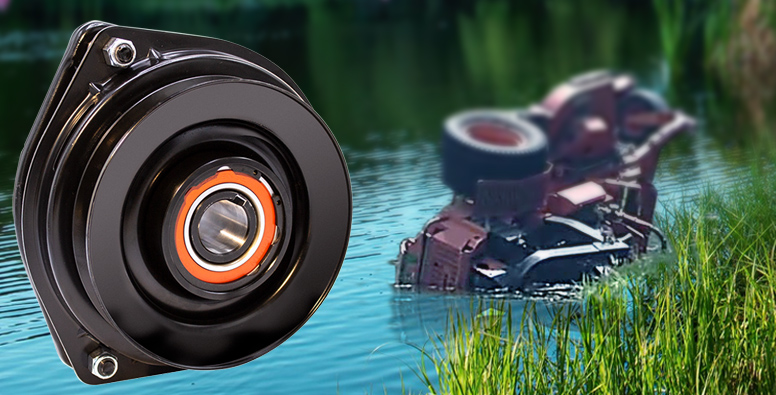Notice: Undefined index: cid in /home/ogurasas/public_html/featured_product_pto.php on line 142

What happens to my clutch when my machine falls into water or gets caught in a flood?
Flash floods, hurricanes, driving into a pond, etc., are all real possibilities for an owner of a residential or commercial mower. If your Ogura PTO clutch brake gets submerged in water, this is what you can expect, along with some tips to solve the associated issues.
 |
Remove the machine from sitting water as soon as safely possible. The clutch is located under the deck so it will not take much water to submerge it. | |
 |
Disconnect the battery and then the connectors on the clutch. Wet connectors can rust at the terminals. If rust has already started to set in, try to gently brush the metallic terminals to remove the rust to provide a good electrical connection. |
|
 |
If covered in mud, wash that mud from the clutch with water. Excess mud will work as an insulator and prevent a clutch from cooling off properly during use. Avoid using high pressure spray directly on the bearing seals. At this point, hopefully the seal pressure was enough to keep the water out. Water contamination to bearing grease lowers the viscosity of the lube which can result in a quick bearing failure. |
|
 |
Let everything dry out. |
|
 |
Don't spray any oils or preservatives close to where they can reach the clutch's friction surfaces. |
|
 |
The clutch coil should be ok. The coil is held in place and partially protected by an epoxy. When the clutch is dry, use an ohms meter on the clutch lead wires or connector to check the resistance. If the coil resistance is still within the approved range, it should be ok to use again when everything dries out. |
|
 |
If there is extreme rust of the clutch friction surfaces, they make be locked together. While not an ideal situation, if the rust is light enough, you may be able to use screwdriver and light hammer to gently knock it loose. You have to be careful not to cause additional damage and this should only be attempted as a last resort. |
|
 |
After all parts have dried and the machine is running again, there may be some rust on the friction surfaces of the clutch brake. |
If the rust is not severe, it should wear off during cycling. Cycle the clutch on and off at idle speed. Make sure to take your time with cycling because dynamic engagements cause heat and you do not want to overheat your clutch. Cycling every 30 seconds should be adequate. Depending on the level of rust, it may need more cycles. A good estimate might be 40 or 50 cycles. Every clutch will be different. You want to make sure the surface is clean again and that there is good metal to metal contact. This will provide the ability to transfer the necessary torque and will prevent clutch slipping and associated problems.
Ogura GT series PTO clutch-brakes are made in a variety of configurations and typically mount on gas and diesel engines rated up to 40 HP. Bore sizes match the typical engine shaft sizes. Pulley sizes can vary based on machine requirements. Some have hub outputs to mount your own pulley, sprocket or coupling half. Clutch torque is rated up to 400 lb-ft on the larger units. These clutches typically operate on 12 or 24VDC.
Benefits of using an Ogura mobile and general purpose clutches:
- Long life
- Safety
- Fuel and energy savings
- Built for outdoor operation
- Many years of proven success
- For use with operator presence controls
- Reduced engine load on cold weather starts
- Available with a soft start controller
- Custom designs available based on minimum order quantities
